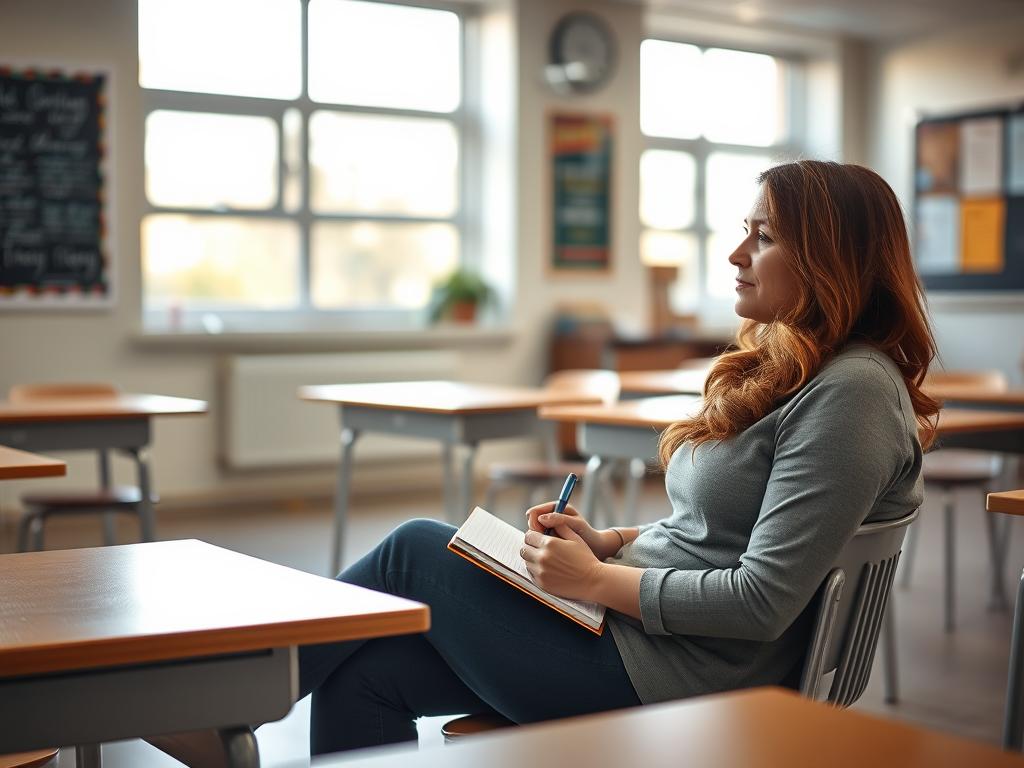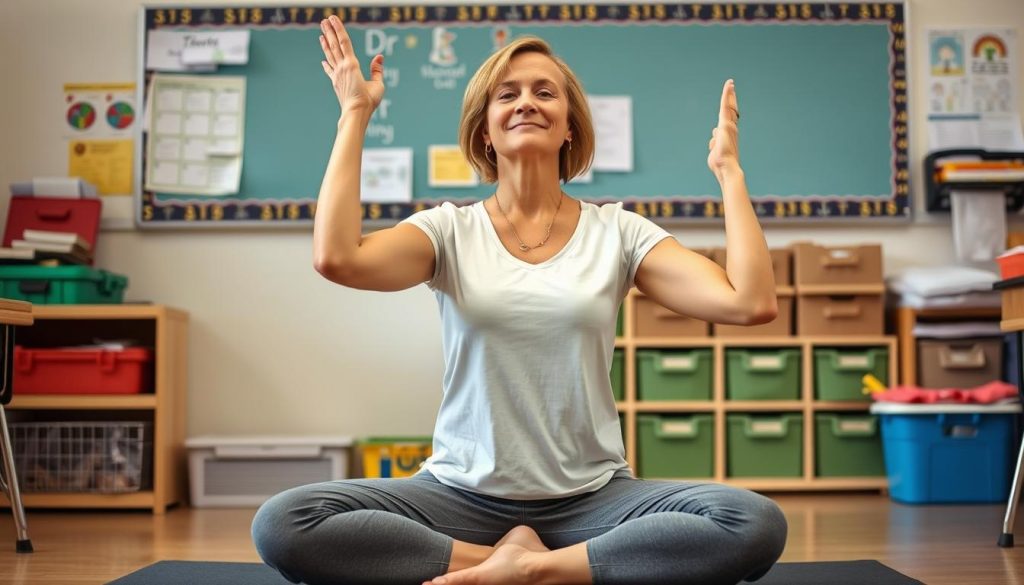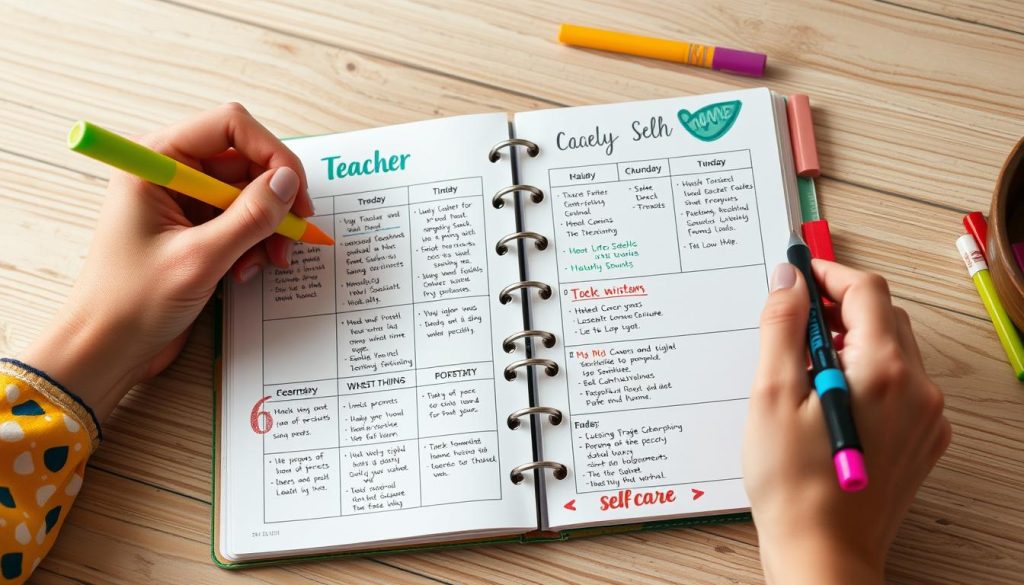Why Teacher Self-Care Matters More Than Ever
Teacher burnout has reached critical levels, making self-care essential for educator wellbeing and effectiveness.
According to a 2021 RAND Corporation study, nearly one in four teachers were considering leaving their profession due to stress and burnout—a situation only exacerbated by the pandemic. The pressure to meet academic standards, manage classroom behaviors, communicate with parents, and complete administrative tasks can be overwhelming. Add to that the emotional labor of supporting students through their own challenges, and it’s no wonder teachers are feeling depleted.
Self-care isn’t selfish—it’s necessary. Just as flight attendants instruct passengers to secure their own oxygen masks before helping others, teachers must attend to their own wellbeing to effectively support their students. When we practice consistent self-care, we not only prevent burnout but also model healthy coping mechanisms for our students.
Developing strong teacher skills requires more than just mastering curriculum and pedagogy—it demands emotional resilience, stress management, and work-life balance. These skills are cultivated through intentional self-care practices that allow us to show up as our best selves in the classroom each day.
Reflect: The Foundation of Teacher Self-Care

Reflection is the first essential step in the self-care journey. Before we can make meaningful changes, we need to understand our current state—physically, emotionally, and professionally. Reflection helps us identify stressors, recognize patterns, and connect with our authentic needs and values.
Daily Check-Ins: A Teacher’s Self-Awareness Practice
One of the most powerful reflection tools is the daily check-in. This simple practice involves taking a few minutes at the beginning or end of each day to assess how you’re feeling. Ask yourself: How is my energy level today? What emotions am I experiencing? What went well? What challenged me? These questions help develop self-awareness, a foundational teacher skill that impacts everything from classroom management to student relationships.
Try setting a timer for just three minutes each morning before students arrive. Use this time to breathe deeply and scan your body and mind. This brief practice can ground you for the day ahead and help you recognize when you need additional support.
Journaling: Capturing Insights and Patterns
Journaling is another powerful reflection tool that can transform your teaching practice and personal wellbeing. By documenting your experiences, challenges, and victories, you create a record that reveals patterns over time. Many teachers find that keeping a dedicated self-care journal helps them track their progress and identify triggers that deplete their energy.
“When I started journaling about my classroom experiences, I noticed that certain types of interactions consistently drained my energy. This awareness allowed me to develop specific teacher skills to handle these situations more effectively, preserving my emotional resources.”
— Maria L., 5th Grade Teacher
Consider using structured reflection prompts designed specifically for educators. These can help you focus your thoughts and gain deeper insights into your teaching practice and self-care needs.
Mindful Observation: Noticing Without Judgment
Mindfulness—the practice of paying attention to the present moment without judgment—is a powerful reflection tool. As teachers, we’re trained to evaluate and assess, but this critical mindset can be exhausting when turned inward. Learning to observe your thoughts, feelings, and physical sensations without immediately trying to fix or change them is a valuable teacher skill that supports emotional regulation.
Try this simple mindfulness practice: Set a timer for five minutes and simply notice your breathing. When thoughts arise (and they will), acknowledge them without judgment and gently return your attention to your breath. This practice strengthens your ability to respond rather than react to classroom challenges.
Enhance Your Reflection Skills
Discover structured reflection exercises designed specifically for educators. Our comprehensive resources help you develop the self-awareness that forms the foundation of effective self-care.
Release: Essential Self-Care Strategies for Letting Go

After reflection comes release—the practice of letting go of tension, stress, and unhelpful thought patterns. As teachers, we carry not only our own stress but often absorb the emotional needs of our students. Learning to release this accumulated tension is crucial for sustainable self-care and maintaining effective teacher skills.
Physical Release: Moving Your Body to Clear Your Mind
Our bodies store stress in physical ways—tight shoulders, clenched jaws, shallow breathing. Regular physical movement helps release this tension and produces endorphins that naturally elevate mood. The type of movement doesn’t matter as much as finding something you enjoy and can sustain.
Many teachers find that even brief periods of movement throughout the day can make a significant difference in their energy levels and emotional regulation—a key teacher skill for maintaining classroom harmony. Consider these accessible options:
- A 10-minute walk during lunch or planning periods
- Simple stretches between class transitions
- Quick yoga poses that can be done in professional attire
- Dancing to a favorite song before or after school
- Taking the stairs instead of the elevator

Emotional Release: Processing Feelings Effectively
Teaching involves significant emotional labor—managing our own feelings while supporting students through theirs. Without proper release, these emotions can build up and lead to compassion fatigue or burnout. Developing healthy emotional release strategies is a vital teacher skill that supports longevity in the profession.
Consider these practices for emotional release:
Talk It Out
Find a trusted colleague, friend, or therapist with whom you can process challenging classroom experiences. Sometimes simply verbalizing our feelings helps release their intensity.
Creative Expression
Engage in creative activities like art, music, or writing that allow you to express emotions that might be difficult to articulate. Many teachers find that creative hobbies provide a necessary counterbalance to the structured nature of teaching.
Boundary Setting
Learn to say no to additional responsibilities when your plate is full. Setting healthy boundaries is a crucial teacher skill that prevents overextension and preserves energy for what matters most.
Digital Detox
Designate specific times to disconnect from email, social media, and other digital demands. The constant accessibility enabled by technology can make it difficult to truly release work stress.
Mental Release: Quieting the Teacher Brain
Teachers are natural planners and problem-solvers, but this mental activity can become exhausting when it never stops. Learning to quiet the “teacher brain” is an important self-care practice that allows for true rest and recovery.
A 2019 study found that mindfulness practices significantly reduced teacher stress and improved classroom climate. These practices help release rumination about past events and anxiety about future ones, allowing teachers to be more present both in and out of the classroom.
“I used to lie awake at night replaying classroom interactions and planning for the next day. Learning to release these thoughts through meditation has transformed my sleep quality and my teaching effectiveness.”
— James T., High School English Teacher
Try this simple breathing technique to release mental tension: Breathe in for a count of four, hold for a count of seven, and exhale for a count of eight. Repeat this cycle four times whenever you notice your mind racing with work-related thoughts outside of work hours.
Master the Art of Release
Our comprehensive Self-Care course teaches educators practical techniques for releasing physical, emotional, and mental tension. Learn strategies you can implement immediately to reduce stress and prevent burnout.
Recharge: Replenishing Self-Care Practices for Educators

The final component of the self-care framework is recharge—intentionally replenishing your physical, emotional, and mental resources. Teaching is a profession of giving, and without deliberate recharging practices, even the most passionate educators can find themselves running on empty.
Physical Recharging: Nourishing Your Teacher Body
The physical demands of teaching are often underestimated. From standing for long periods to managing classroom materials, teaching is a physically active profession. Caring for your body is a fundamental self-care practice that directly impacts your teacher skills and classroom presence.
Consider these physical recharging strategies:
- Prioritize sleep – Aim for 7-8 hours of quality sleep to support cognitive function and emotional regulation.
- Stay hydrated – Keep a water bottle at your desk and set reminders to drink throughout the day.
- Nourish with whole foods – Plan simple, nutrient-dense meals that provide sustained energy.
- Take micro-breaks – Even 30 seconds of deep breathing between classes can help reset your nervous system.

Many teachers find that meal prepping on weekends saves valuable time and energy during the week, making it easier to maintain healthy eating habits even during busy periods. This kind of proactive planning is a teacher skill that transfers beautifully between classroom management and personal self-care.
Emotional Recharging: Cultivating Joy and Connection
Teaching can be emotionally draining, especially when supporting students through challenges. Intentionally cultivating positive emotional experiences helps balance this emotional labor and prevents compassion fatigue.
Effective emotional recharging practices include:
Gratitude Practice
Take a few minutes each day to note three things you’re grateful for in your teaching experience. This simple practice shifts attention from challenges to positive aspects of your work.
Celebration Rituals
Create small rituals to celebrate classroom victories, both big and small. Acknowledging progress reinforces your teacher skills and reminds you of your impact.
Meaningful Connection
Nurture relationships outside of school that allow you to connect as a whole person, not just as a teacher. These connections remind you of your multifaceted identity.
Laughter and Play
Incorporate activities that bring genuine joy and laughter into your routine. Play isn’t just for students—it’s a powerful recharging tool for teachers too.
Mental Recharging: Stimulating Intellectual Curiosity
Teachers are natural learners, but the demands of teaching can sometimes leave little energy for personal intellectual growth. Making time for mental stimulation outside of curriculum planning is an important aspect of self-care that keeps your teaching fresh and engaging.
Consider these mental recharging activities:
- Read books unrelated to teaching that spark your curiosity
- Take courses in areas of personal interest
- Engage in stimulating conversations about topics beyond education
- Pursue hobbies that challenge your mind in different ways than teaching does
“I found that when I made time for my own learning—completely separate from my teaching subject—I returned to the classroom with renewed enthusiasm and creative teaching ideas. My personal intellectual engagement directly enhanced my teacher skills.”
— Sophia R., Middle School Science Teacher
Many educators find that professional development opportunities that align with personal interests can serve the dual purpose of advancing career goals while providing mental stimulation that recharges their teaching passion.
Creating a Sustainable Self-Care Plan for Your Teaching Life

The most effective self-care isn’t a one-time event but a consistent practice integrated into your teaching life. Creating a sustainable plan means identifying practices that realistically fit into your schedule and address your specific needs as an educator.
Assess Your Current Self-Care Landscape
Begin by honestly assessing your current self-care practices. What’s working well? Where do you feel depleted? Which aspects of teaching drain you most? Understanding your unique needs helps you target your self-care efforts effectively.
Consider these dimensions of teacher wellbeing:
Physical Wellbeing
Sleep quality, nutrition, hydration, movement, and physical comfort in your teaching environment
Emotional Wellbeing
Stress management, emotional regulation, work-life boundaries, and supportive relationships
Professional Wellbeing
Sense of purpose, recognition, growth opportunities, and workload management
Start Small and Build Gradually
One of the biggest mistakes teachers make with self-care is trying to overhaul everything at once. This approach typically leads to abandoning self-care efforts entirely when time gets tight. Instead, start with one small, sustainable practice in each area of the 3 Rs framework:
- Reflect: A two-minute end-of-day reflection on what went well
- Release: A five-minute stretching routine between classes
- Recharge: A 15-minute reading break with a cup of tea before bed
As these small practices become habits, you can gradually expand your self-care repertoire. This incremental approach is a valuable teacher skill that applies to both classroom management and personal wellbeing.
Integrate Self-Care Into Existing Routines
Finding extra time for self-care can feel impossible in a teacher’s packed schedule. Instead of viewing self-care as “one more thing to do,” look for ways to integrate it into activities you’re already doing:
Morning Routine
Add three deep breaths before checking email or a moment of gratitude while brewing coffee
Commute Time
Listen to uplifting podcasts or practice mindful driving instead of mentally rehearsing the day ahead
Lunch Break
Eat mindfully away from your desk, even if just for 10 minutes, rather than working through lunch
Transition Home
Create a simple ritual that marks the end of the teaching day, like changing clothes or taking a short walk
Accountability and Community Support
Self-care is more sustainable when shared with others. Consider forming a self-care accountability group with colleagues or joining an online community of educators committed to wellbeing. Sharing challenges and successes helps normalize self-care as an essential aspect of teaching excellence rather than an optional luxury.
Many schools are now recognizing that supporting teacher wellbeing benefits the entire educational community. Ask about professional development opportunities focused on teacher self-care, which can provide both structured support and validation of these important practices.
Transform Your Teaching Experience Through Self-Care
Ready to prioritize your wellbeing and enhance your teacher skills? Our comprehensive Self-Care course offers practical strategies designed specifically for educators’ unique challenges.
Overcoming Common Obstacles to Teacher Self-Care

Even with the best intentions, teachers often encounter obstacles that derail self-care efforts. Recognizing these common challenges and developing strategies to overcome them is itself an important teacher skill that supports sustainable wellbeing.
Common Self-Care Obstacles
- Time constraints – Feeling there’s never enough time for self-care
- Guilt – Believing self-care is selfish when students have needs
- Perfectionism – Setting unrealistically high standards for teaching and self-care
- Lack of support – Working in environments that don’t value teacher wellbeing
- Compassion fatigue – Emotional depletion from caring for others
Effective Solutions
- Time reframing – Viewing self-care as essential to teaching effectiveness, not separate from it
- Permission giving – Recognizing that your wellbeing directly impacts student outcomes
- Progress orientation – Celebrating small self-care wins rather than seeking perfection
- Community building – Creating supportive networks with like-minded colleagues
- Boundary setting – Establishing clear limits that protect your energy and time
The Myth of “No Time” for Self-Care
The most common obstacle teachers cite is lack of time. However, effective self-care doesn’t always require large time commitments. Many powerful practices take just minutes and can be integrated into transitions you’re already making throughout your day.
Consider these micro self-care practices that take less than two minutes:
- Three deep breaths before entering your classroom
- A quick shoulder and neck stretch while papers are being passed out
- A moment of gratitude while waiting for copies to print
- A brief visualization of success before a challenging lesson
These small practices may seem insignificant, but they can interrupt stress cycles and prevent the accumulation of tension throughout the day. The ability to reset quickly is a valuable teacher skill that supports classroom management and instructional effectiveness.
Addressing the Guilt Factor
Many teachers feel guilty prioritizing their own needs when students have so many unmet needs. This mindset often leads to self-sacrifice that ultimately diminishes teaching effectiveness. Reframing self-care as an ethical professional responsibility rather than a personal indulgence can help overcome this guilt.
“I used to feel guilty taking time for myself when I had ungraded papers waiting. Then I realized that when I returned to those papers after a short break, I graded them more efficiently and provided better feedback. Self-care actually made me a more effective teacher.”
— Carlos M., High School History Teacher
Remember that modeling healthy self-care practices for your students is itself a valuable teaching moment. When students see you prioritizing wellbeing, you’re teaching them important life skills that extend beyond academic content.
Measuring the Impact of Self-Care on Your Teaching Practice
How do you know if your self-care practices are working? While wellbeing is subjective, there are both qualitative and quantitative ways to measure the impact of self-care on your teaching practice and overall quality of life.
Indicators of Effective Self-Care
Look for these signs that your self-care practices are having a positive impact:
Physical Indicators
- Improved energy levels throughout the teaching day
- Better sleep quality and duration
- Fewer stress-related physical symptoms
- Quicker recovery from illness
Emotional Indicators
- Greater emotional resilience when facing challenges
- More frequent positive emotions like joy and satisfaction
- Reduced reactivity to student behaviors
- Increased patience and compassion
Professional Indicators
- Enhanced classroom management skills
- More creative and engaging lesson planning
- Improved relationships with colleagues
- Renewed sense of purpose in teaching
Tracking Your Self-Care Journey
Consider keeping a simple self-care tracker to monitor your practices and their effects. This doesn’t need to be elaborate—even noting key indicators on a weekly basis can reveal patterns and progress over time.
Many teachers find that tracking helps them identify which specific self-care practices have the most significant impact on their teacher skills and classroom presence. This information allows you to refine your approach and focus on high-impact practices when time is limited.
Digital tools like wellness apps can simplify tracking, or you might prefer a dedicated section in your teaching planner. The format matters less than the consistent practice of noticing and recording your self-care efforts and their effects.
For a more structured approach to measuring your self-care progress, consider the resources available through Credits for Teachers, which offers assessment tools specifically designed for educators.
Embracing Self-Care as an Essential Teacher Skill
Self-care isn’t separate from teaching excellence—it’s foundational to it. The 3 Rs framework—Reflect, Release, Recharge—offers a comprehensive approach to nurturing your wellbeing as an educator. By integrating these practices into your daily routine, you’re not just preventing burnout; you’re enhancing your teacher skills and modeling healthy patterns for your students.
Remember that self-care is highly personal. The specific practices that replenish you may differ from those that work for your colleagues. The key is consistency and intentionality—making regular deposits into your wellbeing account rather than waiting until you’re completely depleted.
As you continue your self-care journey, be patient with yourself. Like any important skill, effective self-care develops over time through practice and refinement. Celebrate small victories, learn from setbacks, and remember that caring for yourself is not a luxury—it’s an essential aspect of sustainable, joyful teaching.
Your students deserve the best version of you, and so do you. By prioritizing self-care, you’re making a powerful investment in your teaching career, your students’ learning experience, and your own quality of life.
Ready to Prioritize Your Wellbeing?
Take the next step in your self-care journey with our comprehensive resources designed specifically for educators. Learn practical strategies to reflect, release, and recharge while enhancing your teacher skills.




